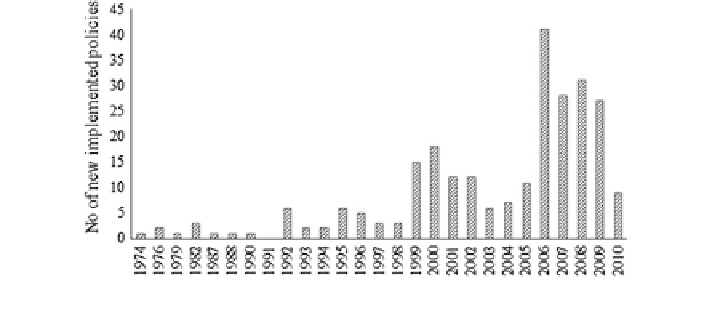Environmental Engineering Reference
In-Depth Information
have been introduced in Australia, Canada and Japan, and numerous standby power
requirements, planned in 2009, have been fully implemented. Moreover, most
OECD countries continue to phase out inef
cient incandescent lamps. Canada,
Japan, the Netherlands, the United Kingdom and the US have also supported
international efforts to stimulate adoption of higher-ef
ciency alternatives to fuel-
based lighting in off-grid communities in developing countries.
Although OECD countries have a strong tradition of promoting EE (dating back
to the two oil crises of the 1970s), residential-related EE regulations have been
consistently promoted only since the early 1990s. Considering the 23 OECD
countries analysed as a whole, 253 different policies can be identi
ed for the
1974
2010 period, 245 of which have been implemented since the 1990s (Fig.
5
).
The
-
rst major peak in residential-related policy implementation occurred at the
turn of the millennium (15 new regulations in 1999 and 18 in 2000), though 2006,
with 41, was the year with the most policies implemented. After 2006, government
law-making in residential-related EE continued to be signi
cant until 2009, with an
average of more than 25 new regulations per year. In 2010, there was a slowdown,
with only nine new regulations implemented.
There has been an interesting trend in the policy framework of public regulations
in OECD countries over the last two decades. Policy packages have become more
heterogeneous, and have shown an increasing level of diversity in terms of both the
instruments implemented and the targets at which they have been aimed.
Figure
6
provides a chronology of the introduction of alternative policy types in
the OECD countries analysed. Each point in the scatter plot represents the year in
which a speci
c policy type was
rst introduced in the country indicated. As
expected, policy types were
rst implemented at different times. The countries
analysed seem to have preferred
rst to implement regulatory instruments (e.g.
codes and standards, obligation schemes). Then economic instruments (e.g. direct
investment,
nancial incentives) and information and education instruments
(e.g. performance labelling) are further implemented in the 1990s. Policy support
scal/
Fig. 5 Overall residential-related EE policies in wealthy OECD countries (1974
-
2010).
Source
own work based on IEA [
37
]

Search WWH ::

Custom Search